|
Marty Richard, call sign OPUS, has been an F-15 pilot for 12 years.
He flew in the Gulf War and has piloted commercial jets
professionally. Now a fighter pilot in the 102nd Fighter Wing, OPUS
flies patrol missions out of Otis Air National Guard Base on Cape
Cod in Massachusetts. On the day NOVA visited OPUS he was on alert,
meaning that he could be called into the air at a moment's notice.
To find out what OPUS is wearing, click on the labels below.

G suit | Helmet |
Night Vision Goggles |
Mask | Exposure suit |
Gloves | Liner suit |
Boots | Harness |
Maps | Flotation device |
Survival vest
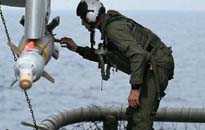
|

|
G suit
A pilot's G suit (also called "anti-G suit") is a one-piece
jumpsuit that protects him from feeling discomfort and losing
consciousness from the pressure of G-forces bearing down on
him. G-forces are the forces of gravity that smack into the
pilot as his plane speeds through the air; the faster he
accelerates or decelerates, or changes direction, the greater
the G-forces. For example, a person on a roller coaster might
experience two or three Gs—two or three times his own
body weight—pushing his head and body backwards during
the fastest parts of the ride. A fighter pilot coming out of a
dive can experience up to nine Gs pushing against him, which
prevent his blood from properly circulating around his body.
Since a person can lose consciousness facing such Gs, a
fighter pilot must wear a G suit, which is filled with a
continuous flow of air. The air puts pressure on the pilot's
abdomen and legs in order to keep blood from accumulating in
those areas and starving his brain.
|
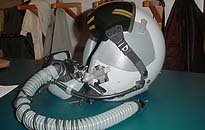
|

|
Helmet
A pilot's custom-fitted helmet serves multiple purposes. It
provides noise protection and cushions the head, reducing the
pressure of extreme acceleration, which can cause headaches
and swollen sinuses. Its padding and shape force its wearer's
head forward towards the oxygen mask to ensure maximum intake
of air. It helps to identify the pilot, whose call sign is
stenciled across it. With its tinted visor, it shields the
pilot's eyes from the sun. Lastly, the helmet contains radio
equipment for communicating with other pilots and with ground
control.
|
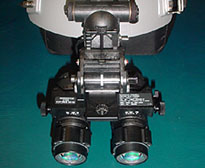
|

|
Night Vision Goggles
Night Vision Goggles (NVGs) allow a fighter pilot to fly in
the middle of the night. By amplifying even the slightest
visible light from inside the cockpit, NVGs illuminate the
night in an emerald green and make potential targets visible.
At a cost of $7,000 each, a pair of NVGs is the most expensive
tool a fighter pilot carries. The goggles attach directly to
the pilot's helmet and are used throughout a night flight,
including during take-off and landing.
|
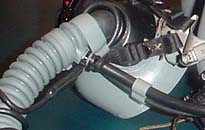
|

|
Mask
A pilot's oxygen mask is one of his key in-air survival tools.
He receives breathable air through the regulator in his mask
while flying. The mask automatically and continuously delivers
air through a so-called "open circuit" so the pilot does not
have to inhale to initiate airflow.
|
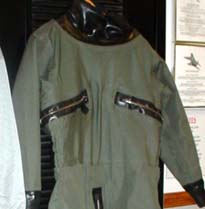
|

|
Exposure suit
In cold weather, a pilot will zip on his rubber-lined exposure
suit (also called a "poopie suit" or "anti-exposure suit")
underneath his flight suit. The exposure suit functions like a
diver's dry suit, keeping him warm in the event that he lands
in water following ejection. Exposure suits designed for the
newest fighter jets, like the Boeing F-22, provide additional
protection from chemical and biological agents.
|
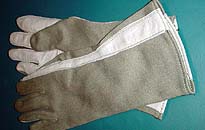
|

|
Gloves
In the air, a fighter pilot wears fire-resistant Nomex gloves,
which protect his hands from extreme heat in the event of
fire. The gloves also keep his hands warm in cold weather.
|
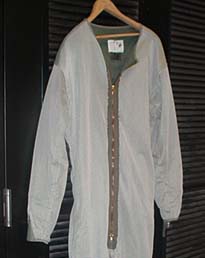
|

|
Liner suit
Made from cotton and Nomex, a pilot wears this suit closest to
his body to keep him warm, protect him from cold and fire, and
absorb moisture. In very cold weather he might wear cotton and
Nomex long underwear beneath his liner suit.
|
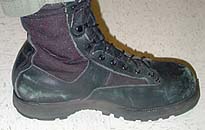
|

|
Boots
Leather boots provide ankle support and protect the feet.
|
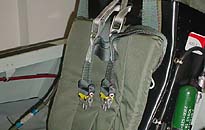
|

|
Harness
Like a seat belt, a pilot's harness buckles him securely into
his ejection seat (seen here).
|
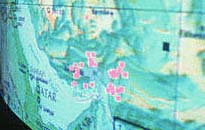
|

|
Maps
Fighter pilots carry waterproof maps and flight plans in a leg
pouch, which can be easily reached from a seated position.
|
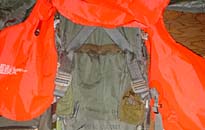
|

|
Flotation device
An automatically inflating life preserver unrolls from inside
the collar of the pilot's harness when
necessary. Also, a fully inflatable raft is tucked into the
pilot's ejection seat, in case he must spend a prolonged
period in the water.
|

|
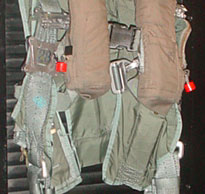
|

|
Survival Vest
Aptly named, a fighter pilot's survival vest contains
all the components necessary for his survival after
ejection and a few tools used in the cockpit, from the
most hi-tech to the most mundane. For example:
|

|

|
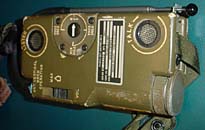
|

|
Radio and beacon
The radio is used for communication after ejection. When
a pilot ejects, his sonar beacon automatically engages,
allowing rescuers to pinpoint his position.
|

|

|
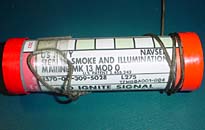
|

|
Flare
A downed pilot can send a flare signal up to 1,250 feet
in the air. These military flares are easily seen in
daylight or at night.
|

|

|
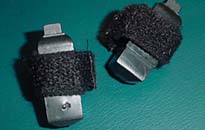
|

|
Finger lights
These tiny thimble-like tools turn a pilot's fingertips
into flashlights, enabling him to read maps and flight
plans inside the cockpit when flying at night.
|

|

|
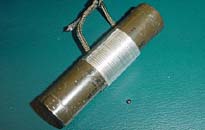
|

|
Camouflage paint
What OPUS calls "green lipstick" is used for disguising
a pilot's face after ejection and landing.
|

|

|
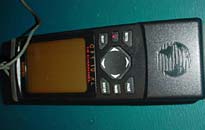
|

|
Global Positioning System (GPS)
With GPS, a downed pilot can tune into satellites in
order to plot his exact location. A pilot keeps two sets
of batteries for this system in his suit at all times.
|

|

|

|

|
Matches
Waterproof, strike-anywhere matches come in handy if a
downed pilot must keep warm or boil water.
|

|

|
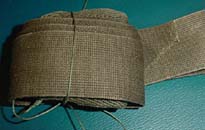
|

|
Tourniquet
If he is wounded, the pilot can tie this tourniquet
around his leg or arm to stem bleeding.
|

|

|
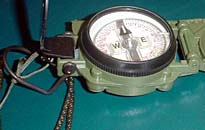
|

|
Compass
If and when GPS fails, a standard military compass can
help a pilot find his way.
|

|

|
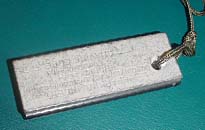
|

|
Fire Starter
Familiar to campers, a single magnesium fire starter can
ignite a fire hundreds of times. Using a sharp knife or
a rock, a downed pilot can scrape this strip to create
an extremely hot spark.
|

|

|
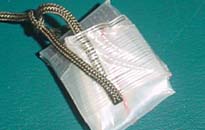
|

|
Infrared Tape
In order to amplify his heat signal, a pilot can apply
infrared tape to his flight suit, allowing rescuers to
locate him quickly on the ground.
|

|

|
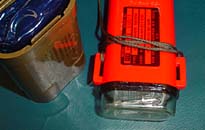
|

|
Strobe Light
Like the flares a pilot carries, this strobe light
allows him to send a bright, easily seen distress
signal.
|

|

|
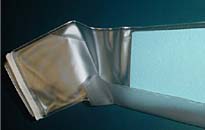
|

|
Relief Bag
Though pilots also carry a supply of plastic bags for
collecting drinking water in case they are downed, this
particular bag serves another purpose. Using the zipper
on the front of his uniform, a pilot can urinate into
this bag in mid-air during long hauls. The plastic bag
contains highly absorbent sponges.
|

|

|
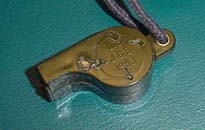
|

|
Whistle
This low-tech but useful tool can serve as a signal to
rescuers or other allies on the ground.
|

|
|

|
|


